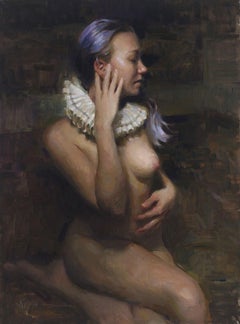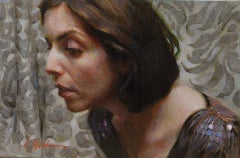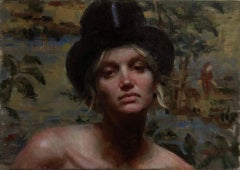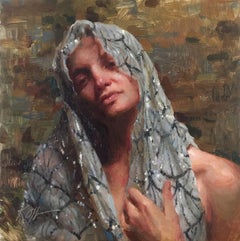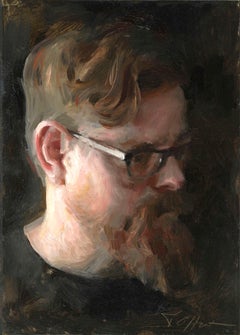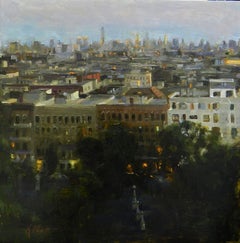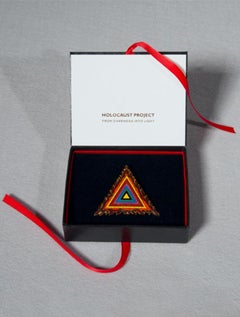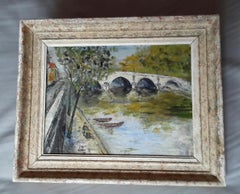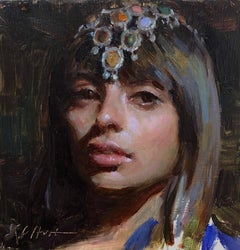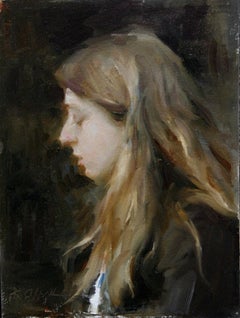Karen Offutt More Art
to
10
5
3
2
7
3
Overall Height
to
Overall Width
to
10
24
183
115
112
86
3
3
2
1
1
Artist: Karen Offutt
Erin
By Karen Offutt
Located in Denver, CO
Erin, 2016
Category
21st Century and Contemporary Karen Offutt More Art
Contained
By Karen Offutt
Located in Denver, CO
Contained, 2016
Category
21st Century and Contemporary Karen Offutt More Art
On with the Show
By Karen Offutt
Located in Denver, CO
On with the Show, 2019
Category
21st Century and Contemporary Karen Offutt More Art
Materials
Oil, Panel
Shell
By Karen Offutt
Located in Denver, CO
Shell, 2017
Category
21st Century and Contemporary Karen Offutt More Art
Materials
Oil, Wood Panel
Jason
By Karen Offutt
Located in Denver, CO
Jason, 2014
Category
21st Century and Contemporary Karen Offutt More Art
South
By Karen Offutt
Located in Denver, CO
South, 2014
Category
21st Century and Contemporary Karen Offutt More Art
Portland Skyscape
By Karen Offutt
Located in Denver, CO
Portland Skyscape, 2016
Category
21st Century and Contemporary Karen Offutt More Art
North
By Karen Offutt
Located in Denver, CO
North, 2014
Category
21st Century and Contemporary Karen Offutt More Art
Shine On
By Karen Offutt
Located in Denver, CO
Shine On, 2018
Category
21st Century and Contemporary Karen Offutt More Art
Materials
Oil, Board
Meghan
By Karen Offutt
Located in Denver, CO
Meghan, 2013
Category
21st Century and Contemporary Karen Offutt More Art
Related Items
Holocaust Remembrance Logo Pin and Pendant
By Judy Chicago
Located in New York, NY
Judy Chicago
Logo Pin and Pendant, 1993
Enameled pin with pendant loop in original presentation box
2 1/2 × 2 1/2 × 1/5 inches
Judy Chicago's incised name and date on the verso
Comes in original presentation gift box
Poignant enameled Holocaust Project Logo pin & pendant based on the logo designed by Judy Chicago for the Holocaust Project: From Darkness into Light
More about pioneering artist Judy Chicago
Judy Chicago (born Judith Sylvia Cohen; July 20, 1939) is an American feminist artist, art educator, and writer known for her large collaborative art installation pieces about birth and creation images, which examine the role of women in history and culture. During the 1970s, Chicago founded the first feminist art program in the United States at California State University, Fresno (formerly Fresno State College) which acted as a catalyst for feminist art and art education during the 1970s. Her inclusion in hundreds of publications in various areas of the world showcases her influence in the worldwide art community. Additionally, many of her books have been published in other countries, making her work more accessible to international readers. Chicago's work incorporates a variety of artistic skills, such as needlework, counterbalanced with skills such as welding and pyrotechnics. Chicago's most well known work is The Dinner Party, which is permanently installed in the Elizabeth A. Sackler Center for Feminist Art at the Brooklyn Museum. The Dinner Party celebrates the accomplishments of women throughout history and is widely regarded as the first epic feminist artwork. Other notable art projects by Chicago include International Honor Quilt, Birth Project, Powerplay, and The Holocaust Project. She is represented by Jessica Silverman...
Category
1990s Abstract Geometric Karen Offutt More Art
Materials
Metal, Enamel
French Post Impressionist Bord de Seine Landscape Painting
By Claude Bouteur
Located in Paris, FR
Charming 1940's Claude Bouteur landscape Oil on a wood panel painting in a Post Impressionist style representing the banks of Seine River and the Pont Marie Bridge, a lovely composit...
Category
20th Century Post-Impressionist Karen Offutt More Art
Materials
Oil, Wood Panel
H 39 in W 46 in D 3 in
Venice at Dusk
By Lucien Whiting Powell
Located in Milford, NH
A fine Italian coastal oil painting with boats titled “Venice at Dusk” by American artist Lucien Whiting Powell (1846-1930). Powell was born in Levinworth Manor, Virginia, joined the 11th Virginia Cavalry at 17 and fought in the Civil War, pursuing his art career after the war, studying with Thomas Moran in Philadelphia and at the Pennsylvania Academy of the Fine Arts. He is also said to have studied in New York City, probably with Moran who moved there in 1872. He was an admirer of British artist J...
Category
Early 20th Century American Impressionist Karen Offutt More Art
Materials
Canvas, Oil, Panel
Portrait Gentleman Black Coat Orange Sash, Dutch Old Master, Oil on Panel c.1650
By Bartholomeus van der Helst
Located in London, GB
This exquisite portrait of a gentleman depicted in a sumptuous black coat edged with silver and slashed sleeves is an excellent example of the type of portrait fashionable in England and the Low Countries during the 17th century. The confident pose, striking orange sash - the colour of the house of Orange Nassau - and the leather gorget imbue the sitter with a sense of masculinity and power. The profusely decorated costume is of the highest quality and de rigueur of an elite class - the artist has carefully cultivated this portrait to emphasise the sitter’s wealth and standing in the society that he belonged to. The casual pose, with one arm resting on a hip, is much less formal than earlier decades, and it speaks of ‘sprezzatura’ – one’s appearance should not appear laborious, but instead, effortless.
The oil on cradled panel portrait can be dated to circa 1650 based on the hairstyle and the attire - small falling collar, short doublet (doublets reduced in size to just below the ribcage in the late 1650’s), and the type of slashed sleeves with the sleeve seams left open to reveal the white fabric.
The demand for portraits in the Netherlands was great in the 17th century. Bartholemeus van der Helst was considered to be one of the leading portrait painters of the Dutch Golden Age surpassing even Rembrandt as the most sought-after portraitist in Harlaam. The Dutch Golden Age, roughly spanning the 17th century, was a period when Dutch trade, science, military, and art were among the most acclaimed in the world. Dutch explorers charted new territory and settled abroad. Trade by the Dutch East-India Company thrived, and war heroes from the naval battles were decorated and became national heroes. During this time, The Dutch Old Masters began to prevail in the art world, creating a depth of realistic portraits of people and life in the area that has hardly been surpassed. The Golden Age painters depicted the scenes that their discerning new middle-class patrons wanted to see. This new wealth from merchant activities and exploration combined with a lack of church patronage, shifted art subjects away from biblical genres. Still life’s of items of everyday objects, landscapes, and seascapes reflecting the naval and trade power that the Republic enjoyed were popular. The new wealthy class were keen to have their portraits commissioned and many artists worked in this lucrative field. Such was the popularity of art that everyone had a painting, even the humble butcher, and hundreds of thousands of paintings were produced.
By tradition the sitter is Maarten Tromp (1598-1653) who was an Admiral in the Dutch Navy (the reverse of the portrait contains an old handwritten inscription “van Tromp”). Certainly, the distinctive orange sash is similar to those worn by officers of the Dutch army in the Netherlands who served under the Princes of Orange and the House of Nassau. However, it should be noted that the physiognomy differs from other images of Tromp.
Tromp was the oldest son of Harpert Maertensz, a naval officer and captain. He joined the Dutch navy as a lieutenant in July 1622 and was later promoted from captain to Lieutenant-Admiral of Holland and West Frisia in 1637. In 1639, during the Dutch struggle for independence from Spain, Tromp defeated a large Spanish fleet bound for Flanders at the Battle of the Downs, which marked an enormous change - the end of Spanish naval power. He was killed in action during the First Anglo-Dutch War in 1653 where he commanded the Dutch fleet in the battle of Scheveningen.
Gloves were an absolutely vital accessory and the elaborate pair in this portrait are embellished with threads of silk and precious metals and salmon-coloured lining. He wears only one glove and holds the other, providing an opportunity to better display the cuffs and detail on his right wrist and forearm. The gloves are probably made from the most prized leather which came from Spain, in particular from Cordova. Cordovan leather was tanned with a special vegetal process that left it both highly impermeable and divinely soft. King Charles I, posed in a rather relaxed manner for Daniel Mytens’s portrait in 1631, is wearing gloves and boots in matching Cordovan leather. The hide is thick, but you can see just how supple it is from the way the gauntlet dimples and the long boot legs fold over themselves, rippling and wrinkling at the ankles.
Apart from keeping hands warm the use of gloves during the 15th through the 19th centuries were full of symbolism and they were worn regardless of the season. They kept the skin unblemished - soft, smooth hands were considered highly attractive. This combination of necessity and proximity to bare skin made gloves a deeply personal gift and they took on a strong symbolic significance and were regarded as emblematic of fidelity and loyalty for hundreds of years. Such was the importance of their symbolism was that some gloves were never intended to be worn at all. Their luxury made them ideal gifts at court, and so in the 15th and 16th centuries, ambassadors often presented them as symbols of loyalty.
Until the mid-19th century, it was customary to give gloves as tokens to guests at weddings and to mourners at funerals. Gentleman often gifted their bride-to-be with a pair of gloves (the obligatory gift) and were handed over at the betrothal and put on display before the wedding took place. It was probably their direct contact with the skin that led to the eroticism of gloves. Not only were pairs often exchanged between lovers, but from the 16th to the 18th centuries, it was common practice to remove one glove and give it as a gift to a favourite. The idea of the item being presented still warm from the wearer’s hand is certainly suggestive. Following the death of King George IV, his executors purportedly found over a thousand mismatched ladies’ gloves among his possessions.
The sentiment of a 17th-century poem reveals the popularity of the practice: “Come to our wedding to requite your loves / Shew us your hands and we’ll fit you with gloves.” Such generosity might be pricey for the hosts, but gloves of varying quality could be offered depending on the status of the recipient. Pairs made with the finest Spanish leather might be reserved for immediate family, while coarse sheep’s leather could be distributed among the servants and tradesmen. The apportioning of quality according to class provided a very clear message of the gloves’ intended use. For refined guests, they were decoration; for the lower classes, they were functional.
Bartholomeus van der Helst...
Category
17th Century Old Masters Karen Offutt More Art
Materials
Oil, Wood Panel
H 38.59 in W 31.89 in D 2.76 in
Portrait of Gentleman, Thomas Bruce, Earl of Elgin c.1638 Manor House Provenance
Located in London, GB
Titan Fine Art present this picture which formed part of a historic collection of an English aristocratic family, Lord and Lady Sandys at their magnificent baroque and Regency Grade-...
Category
17th Century Old Masters Karen Offutt More Art
Materials
Oil, Wood Panel
H 18.9 in W 16.15 in D 1.58 in
Calligrammes, by Guillaume Apollinaire and Giorgio De Chirico
By Giorgio De Chirico
Located in Roma, IT
Format : 2 Volumes, In-4°
Typology : Print Suite
Edition of 100 copies, including 65 original lithographs by Giorgio De Chirico in the text. This copy is in two volumes, unlike the standard edition printed in a unique volume. This edition is part of the only 6 made on Japan Supernacré Paper...
Category
1930s Surrealist Karen Offutt More Art
Materials
Handmade Paper
H 13.12 in W 9.85 in D 3.94 in
Peach XI-Original hyper realism still life oil painting-artwork-contemporary art
By Angela Faustina
Located in London, Chelsea
Angela Faustina's "Peach XI" transports viewers into a realm of hyperrealism, where the luscious allure of a juicy peach is brought to life with breathtaking clarity. As an original ...
Category
21st Century and Contemporary Realist Karen Offutt More Art
Materials
Oil, Panel
Free Shipping
H 11.82 in W 11.82 in D 1.19 in
"Harbor Reflections" contemporary American Modern evening seascape
By Kelly Carmody
Located in Sag Harbor, NY
"Harbor Reflections" is a contemporary American Modern evening seascape.
Kelly Carmody’s work has been widely exhibited and collected. One of her major figurative works was chosen ...
Category
21st Century and Contemporary American Modern Karen Offutt More Art
Materials
Oil, Panel
Metal Classical Style Sculpture of Anteros
Located in Troy, NY
This European metal sculpture, most likely bronze or brass, is probably Anteros, God of requited love. The piece altogether is 18" in height; the figure itself 7.25". The bottom and...
Category
Late 19th Century Romantic Karen Offutt More Art
Materials
Marble, Metal
The Old Barn, Jackson
By Harry Leslie Hoffman
Located in Milford, NH
A lovely impressionist winter oil painting with a farmer going into the barn painted by American artist by Harry Leslie Hoffman (1874-1966). Hoffman was born in Cressona, Pennsylvania, studied in Paris, worked at Yale University, and was a student at the Art Students League with Frank DuMond. He spent much of his life associated with the Old Lyme Colony in Old Lyme, Connecticut. His work was greatly influenced by the impressionist style of Willard Metcalf and became well known for his landscapes, still lifes, and underwater paintings. Oil on panel, signed lower right and on verso, titled in pencil on verso “The Old Barn...
Category
Mid-20th Century American Impressionist Karen Offutt More Art
Materials
Oil, Panel
"Two Roses" - contemporary oil painting, close up of a rose bush - Marc Dalessio
By Marc Dalessio
Located in Sag Harbor, NY
World renowned plein air painter, Marc Dalessio, has captured the essence of two wild roses, how they've grown organically in the natural world. Not trimmed, or arranged at a florist...
Category
21st Century and Contemporary American Impressionist Karen Offutt More Art
Materials
Wood Panel, Oil
"Paradox" oil painting, female nude, drapery, leaf motifs
By Lauren Rinaldi
Located in Philadelphia, PA
This female nude piece titled "Paradox" is an original artwork made from oil on panel by Lauren Rinaldi. This piece measures 24”h x 18”w.
Lauren Rinaldi (b. 1983, Brooklyn, NY) is a...
Category
21st Century and Contemporary Contemporary Karen Offutt More Art
Materials
Panel, Oil
Previously Available Items
Embellished
By Karen Offutt
Located in Denver, CO
Embellished, 2018
Category
21st Century and Contemporary Karen Offutt More Art
Materials
Oil, Panel
On the Streets
By Karen Offutt
Located in Denver, CO
On the Streets, 2012
Category
21st Century and Contemporary Karen Offutt More Art
Portrait of Bre
By Karen Offutt
Located in Denver, CO
Portrait of Bre, 2020
Category
21st Century and Contemporary Karen Offutt More Art
Materials
Oil, Canvas
Karen Offutt more art for sale on 1stDibs.
Find a wide variety of authentic Karen Offutt more art available for sale on 1stDibs. You can also browse by medium to find art by Karen Offutt in oil paint, paint, panel and more. Not every interior allows for large Karen Offutt more art, so small editions measuring 5 inches across are available. Customers who are interested in this artist might also find the work of Jonas Wood, Sally Adams, and Linda King Ferguson. Karen Offutt more art prices can differ depending upon medium, time period and other attributes. On 1stDibs, the price for these items starts at $800 and tops out at $5,600, while the average work can sell for $1,750.
